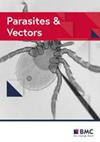Molecular xenomonitoring as an indicator of microfilaraemia prevalence for lymphatic filariasis in Samoa in 2019
IF 3.5
2区 医学
Q1 PARASITOLOGY
引用次数: 0
Abstract
Lymphatic filariasis (LF) is a globally significant, vector-borne, neglected tropical disease that can result in severe morbidity and disability. As the World Health Organization (WHO) Global Programme to Eliminate Lymphatic Filariasis makes progress towards LF elimination, there is greater need to develop sensitive strategies for post-intervention surveillance. Molecular xenomonitoring (MX), the detection of pathogen DNA in vectors, may provide a sensitive complement to traditional human-based surveillance techniques, including detection of circulating filarial antigen and microfilaraemia (Mf). This study aims to explore the relationship between human Mf prevalence and the prevalence of polymerase chain reaction (PCR)-positive mosquitoes using MX. This study compared Mf and MX results from a 2019 community-based survey conducted in 35 primary sampling units (PSUs) in Samoa. This study also investigated concordance between presence and absence of PCR-positive mosquitoes and Mf-positive participants at the PSU level, and calculated sensitivity and negative predictive values for each indicator using presence of any Mf-positive infection in humans or PCR-positive mosquitoes as a reference. Correlation between prevalence of filarial DNA in mosquitoes and Mf in humans was estimated at the PSU and household/trap level using mixed-effect Bayesian multilevel regression analysis. Mf-positive individuals were identified in less than half of PSUs in which PCR-positive mosquito pools were present (13 of 28 PSUs). Prevalence of PCR-positive mosquitoes (each species separately) was positively correlated with Mf prevalence in humans at the PSU level. Analysed at the species level, only Aedes polynesiensis demonstrated strong evidence of positive correlation (r) with human Mf prevalence at both PSU (r: 0.5, 95% CrI 0.1–0.8) and trap/household levels (r: 0.6, 95% CrI 0.2–0.9). Findings from this study demonstrate that MX can be a sensitive surveillance method for identifying residual infection in low Mf prevalence settings. MX identified more locations with signals of transmission than Mf-testing. Strong correlation between estimated PCR-positive mosquitoes in the primary vector species and Mf in humans at small spatial scales demonstrates the utility of MX as an indicator for LF prevalence in Samoa and similar settings. Further investigation is needed to develop MX guidelines to strengthen the ability of MX to inform operational decisions.将分子异种监测作为 2019 年萨摩亚淋巴丝虫病微丝蚴血症流行率的指标
淋巴丝虫病(LF)是一种全球性的病媒传染的被忽视热带疾病,可导致严重的发病率和残疾。随着世界卫生组织(WHO)消除淋巴丝虫病全球计划在消除淋巴丝虫病方面取得进展,我们更需要制定敏感的干预后监测战略。分子异种监测(MX)是对载体中病原体DNA的检测,可为传统的人体监测技术(包括检测循环丝虫抗原和微丝蚴血症(Mf))提供灵敏的补充。本研究旨在利用 MX 技术探讨人类 Mf 感染率与聚合酶链反应(PCR)阳性蚊子感染率之间的关系。本研究比较了在萨摩亚 35 个初级采样单位(PSU)进行的 2019 年社区调查的 Mf 和 MX 结果。本研究还调查了PSU水平上是否存在PCR阳性蚊子和Mf阳性参与者之间的一致性,并以是否存在任何Mf阳性的人类感染或PCR阳性蚊子作为参考,计算了每个指标的灵敏度和阴性预测值。利用混合效应贝叶斯多层次回归分析法,在PSU和家庭/诱捕器层面估算了蚊子中丝虫DNA流行率与人类Mf流行率之间的相关性。在存在PCR阳性蚊子池的PSU中,只有不到一半(28个PSU中的13个)能发现Mf阳性个体。在 PSU 层面上,PCR 阳性蚊子的流行率(每个物种单独计算)与人类 Mf 流行率呈正相关。在物种水平上进行分析,只有波利尼西亚伊蚊在 PSU(r:0.5,95% CrI 0.1-0.8)和诱捕器/住户水平(r:0.6,95% CrI 0.2-0.9)上与人类 Mf 感染率有很强的正相关性(r)。这项研究的结果表明,MX 可以作为一种灵敏的监测方法,用于识别低 Mf 流行率环境中的残余感染。与 Mf 检测相比,MX 能识别出更多有传播信号的地点。在较小的空间范围内,主要病媒物种中估计的 PCR 阳性蚊子与人类中的甲沟炎之间存在很强的相关性,这表明在萨摩亚和类似的环境中,MX 作为甲沟炎流行指标是有用的。需要进一步调查,以制定 MX 指南,加强 MX 为业务决策提供信息的能力。
本文章由计算机程序翻译,如有差异,请以英文原文为准。
求助全文
约1分钟内获得全文
求助全文
来源期刊

Parasites & Vectors
医学-寄生虫学
CiteScore
6.30
自引率
9.40%
发文量
433
审稿时长
1.4 months
期刊介绍:
Parasites & Vectors is an open access, peer-reviewed online journal dealing with the biology of parasites, parasitic diseases, intermediate hosts, vectors and vector-borne pathogens. Manuscripts published in this journal will be available to all worldwide, with no barriers to access, immediately following acceptance. However, authors retain the copyright of their material and may use it, or distribute it, as they wish.
Manuscripts on all aspects of the basic and applied biology of parasites, intermediate hosts, vectors and vector-borne pathogens will be considered. In addition to the traditional and well-established areas of science in these fields, we also aim to provide a vehicle for publication of the rapidly developing resources and technology in parasite, intermediate host and vector genomics and their impacts on biological research. We are able to publish large datasets and extensive results, frequently associated with genomic and post-genomic technologies, which are not readily accommodated in traditional journals. Manuscripts addressing broader issues, for example economics, social sciences and global climate change in relation to parasites, vectors and disease control, are also welcomed.
 求助内容:
求助内容: 应助结果提醒方式:
应助结果提醒方式:


